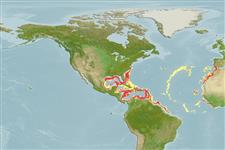>
Gadiformes (Cods) >
Macrouridae (Grenadiers or rattails)
Etymology: Coryphaenoides: Greek, koryphaina = dolphin fish + Suffix oides = similar to (Ref. 45335).
More on author: Vaillant.
Environment: milieu / climate zone / depth range / distribution range
Écologie
marin bathydémersal; non migrateur; profondeur 400 - 2375 m (Ref. 3587). Deep-water; 37°N - 0°N, 98°W - 4°W (Ref. 1371)
Central Atlantic: Western Central Atlantic: off Chesapeake Bay, Gulf of Mexico, and the Caribbean. Eastern Central Atlantic: Mauritania to Côte d'Ivoire.
Taille / Poids / Âge
Maturity: Lm ? range ? - ? cm
Max length : 40.0 cm TL mâle / non sexé; (Ref. 1371)
Épines dorsales (Total) : 2; Épines anales: 0. Head large, completely scaled, including the ventral surfaces of the snout; snout short, narrow, with stout scutes at its tip and lateral angles; mouth small, restricted laterally. Scales with numerous (over 100 in large specimens) short, stout spinules arranged in V-shaped rows. Pyloric caeca short, 10 to 15. Overall color is medium to dark brown; fins generally blackish.
Feeds primarily on benthic organisms, especially gammarian amphipods and, to a lesser extent, lamellibranchs, copepods, polychaetes, ostracods, isopods mysids, Natantia, and echinoderms (Ref. 1371). Minimum depth record from Ref. 1371.
Life cycle and mating behavior
Maturité | Reproduction | Frai | Œufs | Fécondité | Larves
Cohen, D.M., T. Inada, T. Iwamoto and N. Scialabba, 1990. FAO species catalogue. Vol. 10. Gadiform fishes of the world (Order Gadiformes). An annotated and illustrated catalogue of cods, hakes, grenadiers and other gadiform fishes known to date. FAO Fish. Synop. 125(10). Rome: FAO. 442 p. (Ref. 1371)
Statut dans la liste rouge de l'IUCN (Ref. 130435: Version 2024-1)
Menace pour l'homme
Harmless
Utilisations par l'homme
Pêcheries: sans intérêt
Outils
Articles particuliers
Télécharger en XML
Sources Internet
Estimates based on models
Preferred temperature (Ref.
123201): 4.6 - 10, mean 6.2 °C (based on 211 cells).
Phylogenetic diversity index (Ref.
82804): PD
50 = 0.5000 [Uniqueness, from 0.5 = low to 2.0 = high].
Bayesian length-weight: a=0.00214 (0.00109 - 0.00421), b=3.20 (3.03 - 3.37), in cm total length, based on LWR estimates for this (Sub)family-body shape (Ref.
93245).
Niveau trophique (Ref.
69278): 3.2 ±0.37 se; based on food items.
Résilience (Ref.
120179): Faible, temps minimum de doublement de population : 4,5 à 14 années (Preliminary K or Fecundity.).
Fishing Vulnerability (Ref.
59153): Low to moderate vulnerability (30 of 100).
